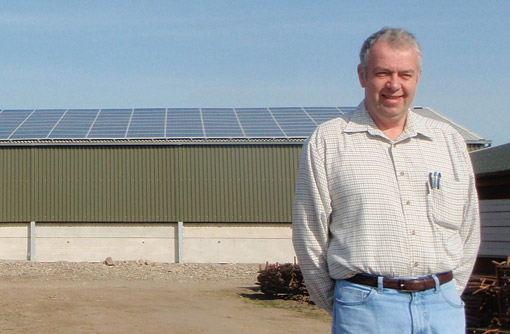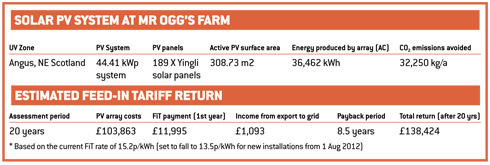Solar ticks the boxes for Scottish producer

Broiler grower Mark Ogg, from Angus in eastern Scotland, is one of many poultry producers who have invested in renewable energy, with the recent addition of a 44.1kPW solar array on one of his poultry shed roofs.
The farm produces 215,000 Ross broilers (308s and 708s), in seven sheds on a standard production system, for the 2 Sisters Food Group. Mr Ogg has been involved in poultry production for 10 years, and the enterprise forms part of a mixed farming system, which also includes arable and pigs.
Mr Ogg was looking for a self-sufficient source of power that would work hardest at times of peak demand, increase his energy efficiency and save money over the long term. Despite his location north of the Firth of Tay, solar PV ticked all of the boxes.
“We use our solar array to power our ventilation systems and for moving feed,” he explains. “Our demand peaks during the hottest time of the day, and hottest months of the year, which is when our 44.41kWp solar PV system is producing the most power.
“We use all the power that we generate, so our energy savings are considerable. The Feed-in Tariff will be reduced, so it’s not about generating income. For us it’s about boosting our efficiency and reducing costs.”
In addition to the obvious financial and efficiency benefits, Mr Ogg says he also turned to solar PV for ease of maintenance and the reliability of the system. “Wind and hydro were also considered, but we didn’t have enough water gradient or the right wind conditions.
“Biodigestion was also on our list, but they are expensive and difficult to operate. With solar PV we have found a system that is ideally suited to our type of business and location. The panels work best when they are cool. We are now in the process of installing another 25kWp array at my pig unit. “
With Feed-in Tariffs set to fall from 1 August, producers looking at making new investments in solar PV will not enjoy the same level of income from that source. But generating electricity in this way will still yield considerable cost savings when compared to buying electricity from the grid at 13p a unit.
“As installation costs have fallen, over its lifetime a solar PV system would pay for itself, regardless of any Feed-in Tariff,” says Tom Morley, managing director of Solar Technology, which installed the system at Mr Ogg’s farm.
“Installing a PV system fixes a proportion of your electricity cost, so helping insulate you against rising energy prices for the next 25 years. And of course, it will reduce the farm’s carbon footprint.”
GETTING IT RIGHT WITH SOLAR PV
As with any renewable energy systems there are risks and challenges that need to be considered. Tom Morley, managing director of Solar Technology, explains:
Choosing the right equipment
“With solar PV, it’s important poultry farmers choose the right panels and cabling systems. Chicken droppings create toxic gases that can damage certain solar PV systems, so it’s critical that the equipment is up to the job. It is best to go for an installer that specialises in commercial-scale solar arrays, preferably with experience in your sector.”
Feasibility studies
“Before embarking on any solar PV installation, it is critically important that the farmer commissions a feasibility report. The feasibility study will inform the design of the solar PV installation, by taking into consideration variables such as UV levels, shade, distance to grid, roof direction and roof pitch. Through bespoke planning, the farmer can be certain the planned development produces the maximum energy return for their site.”
Planning
“Planning permission is often not required for solar PV arrays. A good local installer should be able to advise you about the planning requirements in your area.”
Energy Performance Certificates
“Under the current Department of Energy and Climate Change regulations, an Energy Performance Certificate, giving a classification of D or above, is required on one of the buildings that connects to your electricity supply. This means that the building with the solar array does not necessarily have to obtain the D rating, as long as one of the other buildings, such as a farm office or farmhouse, has the D rating or above and shares the same electricity supply.”

